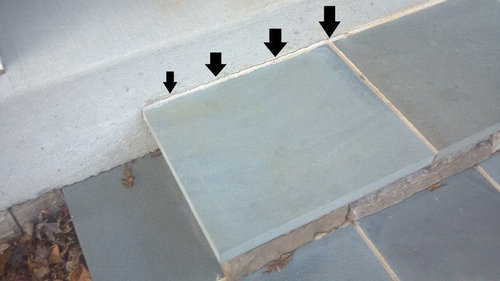Mortar Cracking Connecting Tread to Porch
bobby1973
9 years ago
Related Stories

LIFECreate a 'Forever House' Connection
Making beautiful memories and embracing your space can help you feel happy in your home — even if you know you'll move one day
Full Story
LANDSCAPE DESIGNGarden Walls: Dry-Stacked Stone Walls Keep Their Place in the Garden
See an ancient building technique that’s held stone walls together without mortar for centuries
Full Story
STANDARD MEASUREMENTSThe Right Dimensions for Your Porch
Depth, width, proportion and detailing all contribute to the comfort and functionality of this transitional space
Full Story
ARCHITECTURERoots of Style: Many Cultures Make Their Marks on Mediterranean Design
If you live in California, Florida or certain other parts of the U.S., your architecture may show distinct cultural influences
Full Story
ECLECTIC HOMESMy Houzz: Ecofriendly and Salvaged Style in a Montreal Triplex
Repurposed materials, graywater reuse, and no-VOC paints make for a resourcefully earth-friendly home in Quebec
Full Story
GARDENING AND LANDSCAPINGHardscaping Shows Its Soft Side
Who says hardscaping has to be hard? Consider these gentle, sustainable and DIY-friendly alternatives
Full Story
LANDSCAPE DESIGNHow to Pick the Right Paving and Decking Material
Once you’ve got the walls or fences of your garden figured out, it’s time to consider the ground surface or floors
Full Story
ARCHITECTUREDesign Workshop: The Art of Joining Materials
Watch for carefully crafted meeting points in a home's building materials — they're among the hallmarks of great architecture
Full Story
MOST POPULARA Contractor's Secrets to Hanging Holiday Decor
Hang a wreath or garland on brick, concrete, Sheetrock or wood the professional way — and avoid the potential pitfalls
Full Story
FLOORSAre Stone Floors Right for Your Home?
If you’re thinking about going with this hard-wearing material, here are important pros and cons to weigh
Full StoryMore Discussions











sombreuil_mongrel
Joseph Corlett, LLC
Related Professionals
Ballenger Creek Kitchen & Bathroom Designers · Federal Heights Kitchen & Bathroom Designers · Reedley Kitchen & Bathroom Designers · South Farmingdale Kitchen & Bathroom Designers · Spokane Kitchen & Bathroom Remodelers · York Kitchen & Bathroom Remodelers · Plant City Kitchen & Bathroom Remodelers · Shorewood Interior Designers & Decorators · Barrington General Contractors · Havre de Grace General Contractors · Leominster General Contractors · Millbrae General Contractors · Muskogee General Contractors · Rolling Hills Estates General Contractors · Watertown General Contractorsgeoffrey_b
sombreuil_mongrel
Joseph Corlett, LLC
bobby1973Original Author
Joseph Corlett, LLC
energy_rater_la
renovator8
bobby1973Original Author